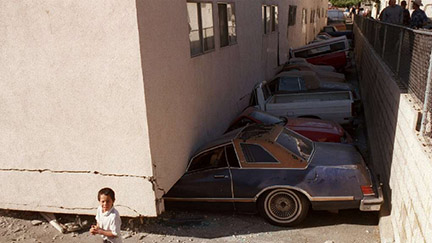JulianConstruction.com: Earthquake Forecast – Big and Bigger
You’ve probably seen more than a few stories about the “Big One”- a magnitude 8.0 or greater earthquake that scientists predict will occur along the San Andreas Fault sometime in the future. Whether that future is an hour from now, next week or decades away is unknown.

The San Andreas Fault runs through California and is approximately 800 miles long. It is the boundary between two of the planet’s tectonic plates, the Pacific plate and the North American plate. Tectonic plates, which are made up of the Earth’s crust and mantle, are in various degrees of motion across the planet. Their movement over time is generally unnoticeable, except in places where they meet.
The San Andreas Fault has three main sections. The southern section starts in Bombay Beach, CA. a small town in Imperial County south of Palm Desert that is 223 feet below sea level – the lowest community in America.
From Bombay Beach, the fault runs through the base of the San Bernardino Mountains, across the Cajon Pass in the Angeles National Forest, and along the San Gabriel Mountains to Parkfield in Monterey County and northwest of Bakersfield. This particular stretch of the fault can produce a quake of up to magnitude 8.1.
The central part of the fault runs from Parkfield to Hollister and the northern segment from Hollister (south of San Jose) to the Mendocino Triple Junction. The Mendocino Triple Junction is where the North American Plate and the Pacific Plate meet up with the Gorda plate.
Experts say that a major earthquake along the San Andreas Fault could last 15 times longer than the 1994 Northridge quake, cause thousands of deaths, tens of thousands of injuries and hundreds of billions of dollars in damage.
But scientists are now claiming that a quake along the lesser known Cascadia fault (technically called the Cascadia subduction zone) could be even deadlier.
The Cascadia fault is 620 miles long, stretching from Cape Mendocino, in northern California and west of Redding, to northern Vancouver Island. It separates the North America plate from the oceanic Juan de Fuca plate. Its name comes from the Cascade Range, a volcanic mountain range located along the same geographical area.
Earthquakes along the fault have been occurring approximately every 243 years. The Pacific Northwest is currently “past due” for a Cascadia fault quake by about 72 years. And that quake, when it happens, is expected to be an 8.0 to 9.2 magnitude seismic event, followed by a devastating tsunami.
According to Kenneth Murphy, a FEMA director for Oregon, Washington, Idaho and Alaska, “Our operating assumption is that everything west of Interstate 5 will be toast.”
With the Big One and Bigger One looming, earthquake preparedness and planning is vital for anyone who lives on the West Coast. Your neighborhood may not end up in a pile of smoldering debris, but you should anticipate a lengthy recovery period while communications are restored and roads are repaired.
Part of that preparation includes earthquake retrofitting your home, especially if the house was built during or before the 1980s. Even a new house should be given a foundation inspection by experienced foundation contractors. Doing everything you can to improve the structural integrity of your home could end up saving lives when the ground begins to shake.





